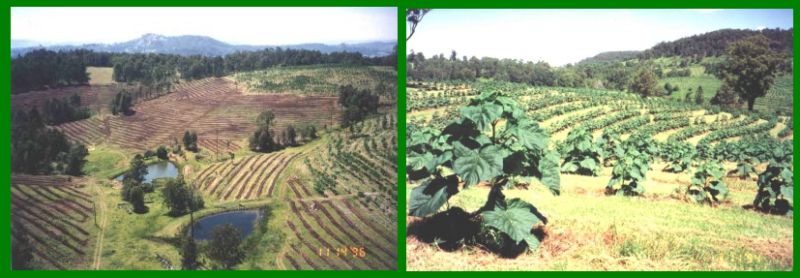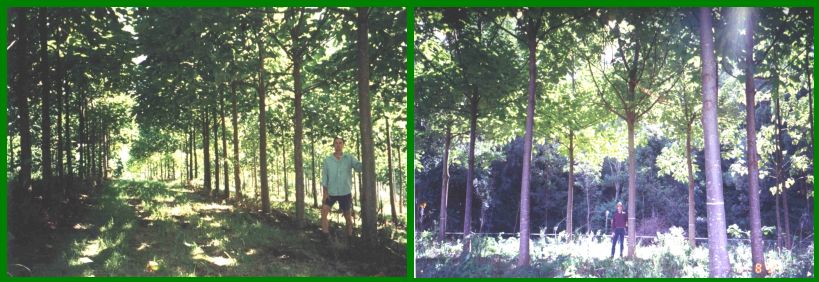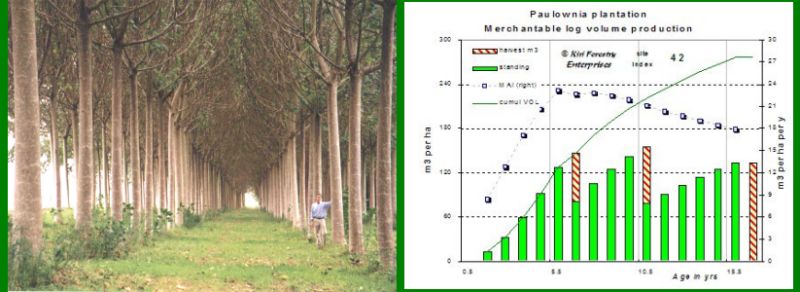Kiri Forestry Enterprises |
Kiri tree management
Paulownia is a fast-growing deciduous hardwood tree native to China which produces valuable timber. The lightweight, straw coloured timber is suitable for furniture and interior mouldings. An exclusive series of clones, the Kiri Jade Empress Trees, have been carefully selected for their desirable commercial forestry characteristics. The use of disease-free mother stocks for propagation ensures that the pathogens endemic to China will not be spread to other areas.
Kiri trees have a deciduous growth habit and deep-rooting behaviour, which means that the plantations are suitable for a variety of inter-cropping possibilities including mixture with cabinet timber trees, flowers and annual crops or vegetables. Seeds of all Paulownia species are short-lived and have low natural viability, and there is little prospect that they will become invasive weeds. The species have beautiful scented flowers in Spring and the leaves provide high protein very palatable grazing fodder.

Specific cost-effective management techniques to promote growth of highest value knot-free butt log have been devised over a period of 15 years experience with Kiri on various sites. On-going research and development and our plantation management activities ensure that this knowledge and experience is constantly being expanded, and we are exploring opportunities for use of marginal or environmentally degraded sites. Manageable risks include fire, drought, and grazing animals. Pests and diseases have not caused problems in Australian plantations to date.
Important criteria for suitable land are
Contact us for a free site evaluation. A summary fact sheet is available here

Planting takes place in Spring or at the start of the rainy season. Well prepared beds and fertiliser are needed, and the trees should be watered immediately after planting to ensure high survival. Weed control, fertiliser and pruning are required during the early years to achieve a rapidly growing forest with commercial potential. With good management the Kiri plantation site can look like the above 3 months after planting
After 3 years, little further management is needed to get your crop through to harvest-ready stage, except where trees are planted on infertile soil or require irrigation. However, neglect in the early years will almost always produce a disappointing result. You must be prepared to keep up the maintenance work and inputs.

Kiri trees are long-lived and can grow very large; they are known to have exceeded 80 years age, attaining 200 centimetres diameter and 50 metres height. An outstanding feature is the rapid growth of young trees, which enables a harvest cycle in a fraction of the time required to grow other hardwoods. By the end of the second year, a well managed tree can be 10 metres or more in height, and we have achieved trunk diameters of over 40 cm, producing quality timber, within 6 years. However, in plantation formation, individual tree growth rates may be lower, and manipulation of plantation stocking density through gradual thinning is important to achieve best returns from the forest. Our silvicultural forecasts have been made using a combination of market-interactive computer modelling and observed growth measurements. We can help you get a result like this plantation in just 7 years.

First harvest can occur just 6 years after planting when plantation trees may reach 25-35 cm in diameter. Highest commercial value is likely to be obtained by taking two to three partial harvests (commercial thinnings) over a longer growing cycle, aiming to produce at age 16-18, a final harvest of around 100 trees per hectare with diameters of 55-65 cm. With good silvicultural management, a 250 hectare plantation with 100,000 trees could produce around 40,000 cubic metres (m3) of sawn product over a full 16 year growing cycle, and this timber is conservatively valued (depending on size and quality) from US$350 to $740 per m3 at current-day prices on the international market.

We are ready to help you to develop a forestry project that suits your environmental and commercial needs, and can offer a range of practical and innovative suggestions. Please take the time to fully consider the information provided here, and feel free to make further enquiries. Click here for a summary fact sheet. |